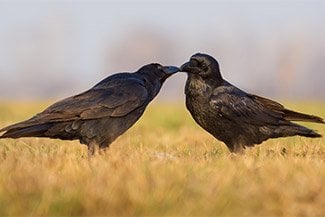Are emotions contagious in crows, too?
 Another study on crows! It’s true, these birds never cease to fascinate scientists. In this latest episode, you’ll discover how researchers tested a psychological phenomenon known as “emotional contagion” in these birds. Here’s the question they wanted to answer: can crows transmit a bad mood ?
Another study on crows! It’s true, these birds never cease to fascinate scientists. In this latest episode, you’ll discover how researchers tested a psychological phenomenon known as “emotional contagion” in these birds. Here’s the question they wanted to answer: can crows transmit a bad mood ?In cognitive science, a person’s ability to attribute mental states (emotions, intentions, desire…) to others or to themselves is known as “theory of mind.” This human ability makes our social relationships more effective. For example, we can quickly detect sadness in another individual simply through their facial expressions. Moreover, one person’s emotions can be quickly transmitted to others. Depending on the communication context, we can also unconsciously take on the same (non-verbal) expressions as our interlocutor. This emotional contagion can also be described as an intertwined emotional state that is shared between individuals. It facilitates communication between complex social groups. Emotional mimicry can be seen when panic breaks out in a crowd, or when laughter fills a theater.
Emotional contagion is a fundamental element of empathy that remains difficult to measure in animals. Most of the time, empirical approaches have been used to measure behavioral contagion and emotional arousal. The authors of the study wanted to conduct an additional assessment: emotional valence. In psychology, this refers to the positive (pleasant) or negative (unpleasant) character of an emotion. A team of cognitive biologists and neuroscientists at the University of Vienna (Austria) was formed to study negative emotional contagion in crows. The birds were an obvious choice because they are highly intelligent and have complex social behavior.
The researchers designed a series of experiments with eight crows, divided into four pairs. The scientists presented each pair with an empty box and another containing cheese (a favorite treat). The scientists then induced a positive or negative emotional state in one of the two birds (the spy) by allowing them to see the contents of another box through a peephole. The box contained either a highly coveted food (doggy kibbles) or an undesirable food (carrots). The other crow (the observer) then observed the behavioral reactions of his peer to the type of food contained in the box (without being able to see it himself).
When the “spy” crows showed frustration-like behaviors, the “observer” crows took longer investigating the third box presented to them, demonstrating a pessimistic outlook. So crows can indeed start “sulking” when they’re exposed to a peer in a bad mood. These results suggest that crows are capable of assessing the emotional state of other crows and can be “contaminated” by them without demonstrating any behavioral contagion (the “observers” didn’t behave like the “spies”).
Although emotional contagion has been observed in other animals like dogs and monkeys, it wasn’t under the same experimental conditions. This is why, according to the authors of the study, “just like humans, animals are driven and motivated by their emotional states, which is reflected in their cognitive performance and behavioral expressions.”
Source: Adriaense, J.E.C., Martin, J.S., Schiestl, M., Lamm, C. & Bugnyar, T. « Negative emotional contagion and cognitive bias in common ravens (Corvus corax) », in Proceedings of the National Academy of Sciences of the United States of America, May 2019. University of Vienna website: “Empathic birds”. https://medienportal.univie.ac.at/presse/aktuelle-pressemeldungen/detailansicht/artikel/empathic-birds/







